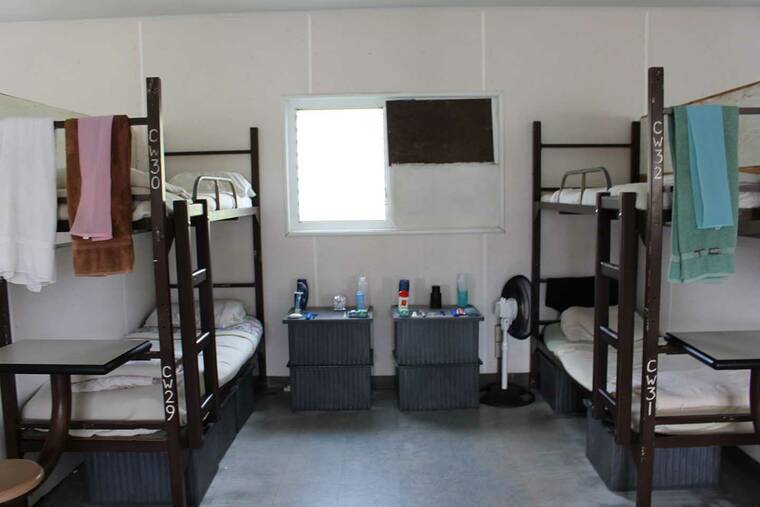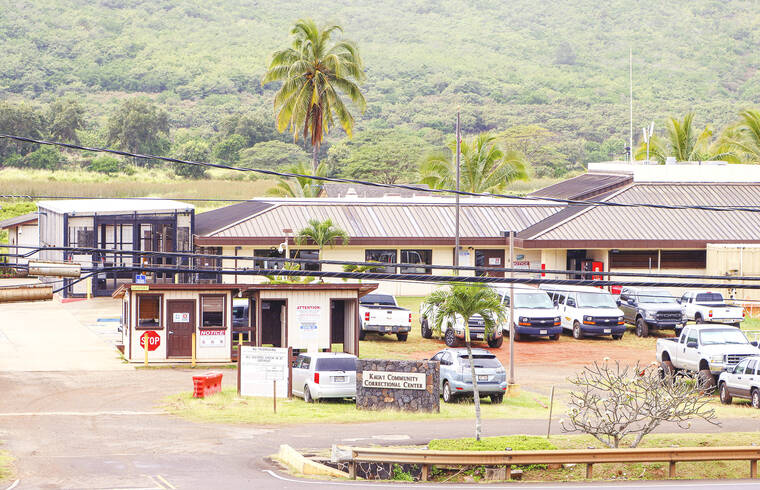LIHU‘E — The Kaua‘i Community Correction Center currently houses 137 inmates — 107% of its operational capacity of 128.
This overcrowding has led to the rapid spread of the COVID-19 virus and backlogs in the legal process.
“It’s impossible for them to social distance in the jail,” said Deputy Public Defender Marisa Agena, who spoke to The Garden Island last week. “Once one person gets it in one room, the whole room ends up getting it.”
At KCCC, 178 inmates and 27 staff have tested positive since the pandemic began, according to the latest state Department of Public Safety data, with 44 this past January alone during the omicron surge.
COVID-19 infection and mortality rates among Hawai‘i’s incarcerated population were both significantly higher than the general population, per a September 2021 report from Prison Policy Initiative.
“The jails and prisons are doing the best they can to provide safe and secure housing during this pandemic,” said DPS spokesperson Toni Schwartz in an email, adding that “overcrowding in the facility makes it extremely difficult to provide adequate space for physical distancing.”
This leads to more individuals sharing space than originally intended, with individual cells “routinely” holding more than their “operational capacity.”
The spread of the virus in jails exacerbates the overcrowding problem in a vicious circle.
Under normal circumstances, an inmate would be arraigned, a bail study will be ordered, and they might be eligible for release. But when a prisoner tests positive, they cannot speak to attorneys or appear in court, even by Zoom, Agena said, leaving them locked up for longer.
“The overcrowding is creating this situation where clients are constantly in quarantine or isolation and it’s preventing court cases from being able to move — creating a lot of backlogs,” said Agena, who dealt with positive cases from several of her clients. “And the more people we keep in the harder it is to properly social distance and quarantine.”
The disappearing
$15 million
A solution to overcrowding seemed within reach back in 2016, when lawmakers and officials celebrated the allocation of $15 million for new housing and offices at KCCC — which, at the time, housed 175 inmates, nearly 50 inmates over its capacity.
But six years later, the facility is still no closer to increasing its holding.
Projects at Hawai‘i Community Corrections Center and Maui Community Corrections Center took priority over Kaua‘i, according to Schwartz.
Bids on expansion projects at HCCC, MCCC and KCCC received in 2020 came in above budget, Schwartz said.
Since the two larger facilities faced more-severe overcrowding issues at the time, the DPS opted to use the KCCC funding to cover shortages on the other two projects.
The HCCC construction project broke ground in January 2022 and the MCCC construction will begin soon. There are no projects in the works to increase capacity at KCCC.
A quarantine solution too late for omicron
A temporary isolation unit from Container Storage of Hawai‘i arrived later than expected at KCCC, in July 2021. After two additional waves of the virus, it is still not operational.
Schwartz described the unit — which resembles a shipping container with four rooms for isolation — as a “secure housing option to medically isolate inmates with COVID-19.”
The late arrival was caused by unexpected delays in the manufacturing and shipping from the mainland, construction-site preparation, back orders of parts and COVID-19 lockdowns.
The unit required electrical hookups, plumbing and specialized security locks before it could be used, a process that has now taken eight months.
Schwartz said that she expected the $124,000 container to be operational within 30 days from now, but the jail had to weather the omicron surge without it.
While inmates who tested positive had a place to medically isolate for a full 10-day quarantine, jail staff were faced with a tough call when it came to new inmates.
“It can become challenging to accommodate a full 10-day intake quarantine,” said Schwartz.
“The overcrowded conditions create a situation where staff at the facilities are faced with a very-difficult decision of whether to cut down the intake-quarantine period for inmates who are nearing the 10th day, display no symptoms and test negative in order to house new intakes who they have absolutely no history on.”
One strategy to cope with inmate infections is the vaccine-incentive program instituted by DPS. The program offered a $50 incentive to all inmates who completed their full vaccinations. By Sept. 2021, the latest available data, 66% of inmates had been fully vaccinated — higher than the nationwide vaccination rate for prisoners, according to a study from UCLA Law. Another program offered inmates $25 to receive a booster shot and, as of Feb. 11, some 1,025 inmates opted to receive the booster.
Another potential solution has simply been to release more inmates.
After petitions from the state Office of the Public Defender, the Hawai‘i Supreme Court issued two orders in 2020 allowing for the release of certain inmates held for non-violent crimes.
“The department supports all reasonable efforts made to safely reduce the inmate population, not only to prevent the spread of disease but also to alleviate the extreme overcrowding our facilities have faced for decades, all while keeping the need for public safety foremost in mind,” said Schwartz.
Between April and June 2020, 650 inmates were released to help ease overcrowding.
These orders expired in March 2021, and a third request from the Office of the Public Defender was denied in October.
•••
Guthrie Scrimgeour, reporter, can be reached at 647-0329 or gscrimgeour@thegardenisland.com.








Newly elected Like, who should have been a public defender, will help Marisa Agena get these poor. ‘victims’ let out on the streets of Kauai. It’s bad enough from that last guy who quit.